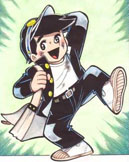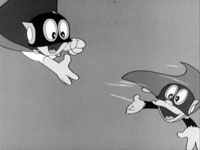
People involved in film preservation can attest to the challenges of finding missing films. Maybe the original masters were thrown out, maybe it got destroyed in a fire, or maybe they just plain forgot where they put it. Typically, films from before 1950s were prone to this.
One would be hard-pressed to think that made-for-TV animation would suffer from missing and lost films, but it does happen. It’s especially the case in Japan. Due to Japanese television having limited rerun potential, and the fact that studios never really saw long-lasting values in their shows after it aired, a lot of anime from the early days of television, especially those shot in black and white, would turn up lost. I figure I would cover some of those missing shows. Note that I’m only covering shows with verified missing episodes. There may be more lost shows that we don’t know are lost.
Astro Boy (1963, Mushi Production)
I wrote about one of the infamous missing episodes here (#34). In addition, episodes 125, 127, 139, 163, and 191 were regarded as lost. 34, 163 and 191 were eventually found, although 125, 127, and 139 are still missing.
Big X (1964, TMS Entertainment)
Yet another series created by Osamu Tezuka, and the second anime to air, after Astro Boy. This was produced by Tokyo Movie (TMS), their very first show. The series focuses on a boy with a drug that can increase his body to that of a giant, a result of a failed experiment from the Nazis during the World War II.
59 black and white episodes were made, but only episodes 1, 11, and 40-59 are known to survive. The survival of episode 1 is due to this website’s own Jerry Beck owning a 16mm print. He announced he was showing the film at an Asifa meting – but a rep from TMS Entertainment attended and cancelled the showing. Jerry was informed that the series was lost, and was asked to loan the print back to the studio so that they can make a video transfer for their archive.
Jerry explains further:
A friend of mine with connections to CBS in New York, obtained the print of “Big X” years ago from an ex-executive of the network. Back in the 1960s, before DVDs, VHS or even 3/4″ U-Matic tapes, networks would be pitched series like this from producers around the world. They would leave (or loan) a 16mm print of the series they were pitching with the network. Perhaps it was to be returned – but it never was. Decades later the print is traded to my friend in a deal including several rare pilots. As it was animated, and in Japanese language, the print was worthless to my friend – who gifted it to me for deposit in my collection.
I had it for several years before I decided to screen it for Asifa with several other 1960s anime prints I had in my collection. An executive from TMS came to the screening – and forbade me from publicly showing the print. We spoke after the meeting. They allowed me to keep the film on condition they could professionally transfer it. A few weeks later I brought the print to the transfer session and sat through the whole process – the print never leaving my sight. I had no idea it was so rare – but I’m so glad I played a part in making it accessible again.
Here’s an excerpt from the first episode:
Space Alien Pipi (1965, Japan Tele-Cartoons)
Of the 52 episodes, only two (37 and 38) are known to exist. More here.
 Harris no Kaze [Whirlwind of Harris] (1966, P Production)
Harris no Kaze [Whirlwind of Harris] (1966, P Production)
The series focuses on a boy named Kunimatsu, a wild child who keeps getting expelled from schools due to him fighting other kids. One day, he meets an principal of Harris Academy, where he enters him in numerous sports club the school has to offer, which allows him to channel his aggression in sports, improving the schools’ atheletic ability. Based on a manga by Tetsuya Chiba. The series was later remade in color as “Make Way for Kunimatsu” in 1971, produced by Mushi Production.
One episode (#64) out of 70 only exists in picture format with no audio, but otherwise the entire series exist.
Theme song:
Robotan (1966, Daiko Production)
35mm picture negatives for a couple of episodes showed up on a Japanese auction website out of a blue several years ago, but otherwise the survival of the entire series is pretty slim, just based on that. More about Robotan here
 Perman (1967, Studio Zero and TMS)
Perman (1967, Studio Zero and TMS)
A superhero parody created by the Fujiko Fujio duo. Perman focuses on a boy who was given tools to become an apprentice to be a superhero (“Perman” is “Superman” without “Su”). The boy is rather clumsy, but with the help of other Permans (including a monkey), he is able to save the day usually.
54 episodes (each half hour split into two segments) of the black and white anime were made, with production alternating equally between Tokyo Movie and Studio Zero. A DVD boxset was released in 2014. The DVDs avoid mentioning that the set is “complete”, because several episodes are missing.
To be specific, episodes 4-A, 17-A, 39-A, and 45-B only exist in picture format, with no audio to be found. Episodes 16-A and 47-A are missing altogether, although one of them can be found online somewhere in a dubbed Portugese format. In the DVD menu, they list those episodes, with a caption “(missing)” next to title. Finally, episodes 26-A and 51-B exist, but in poor quality.

Frame from episode 4-A of Perman. The Japanese text reads ‘Picture Only, Audio Missing’.
Doraemon (1973, Nippon TV Doga)
Of the 26 episodes made, barely half are known to exist. Episode 4 exist in a soundless workprint format. Episodes 5-A, 10-B, 12-B, 18, and 20 through 26 all survive in entirety. In addition, a workprint of the pilot film is reportedly around. More click here.
Animated Travels: Marco Polo Adventures (1979, NHK)
This was an animated documentary on Marco Polo, mixed in with live-action footage. 43 episodes were broadcast on NHK from 1979 to 1980, but only the first and last episodes survive. While the cel animation was shot on film, post-production and editing were done on videotapes (normal for NHK programs), which have since been wiped.
The final episode in two parts:
Of course, sometimes missing episodes do turn up. Episode 11 of Big X was found as recently as last year, when it was broadcast on the Animax network as part of the TMS’s 50th anniversary celebration. And some entire shows were eventually found hidden inside a TV station’s film vault. While it’s not likely every single lost anime will be found, bits and pieces do get discovered eventually.


 Charles Brubaker is a cartoonist originally from Japan. In addition to his work for MAD Magazine and SpongeBob Comics, he also created Ask a Cat for GoComics. You can also follow him on his Tumblr page.
Charles Brubaker is a cartoonist originally from Japan. In addition to his work for MAD Magazine and SpongeBob Comics, he also created Ask a Cat for GoComics. You can also follow him on his Tumblr page.











































MiRoscoe, has TMS gotten better since it started!
They certainly came a long way from Big X (watching that clip, I couldn’t tell the difference between them and Mushi Pro).
I grew up with a lot of these early anime cartoons in the mid 60’s. Astroboy, Kimba the White Lion, Gigantor, 8th Man, Marine Boy, and Speed Racer! They are SUPER FANTAZTIK!
59 black and white episodes were made, but only episodes 1, 11, and 40-59 are known to survive. The survival of episode 1 is due to this website’s own Jerry Beck owning a 16mm print. He announced he was showing the film at an Asifa meting – but a rep from TMS Entertainment attended and cancelled the showing. Jerry was informed that the series was lost, and was asked to loan the print back to the studio so that they can make a video transfer for their archive.
Jerry outta be thankful for that, though I don’t suppose TMS thanked him in the credits of a later home video release back home. His story of how he came across this episode doesn’t sound too far-fetched at all, and could easily have happened to anyone.
To be specific, episodes 4-A, 17-A, 39-A, and 45-B only exist in picture format, with no audio to be found. Episodes 16-A and 47-A are missing altogether, although one of them can be found online somewhere in a dubbed Portugese format.
The fact that any episode could exist at all in another language should be a compliment. Not that TMS is going to go comb the Brazilian TV jungles to look for ’em, but that’s one thought.
Of course, sometimes missing episodes do turn up. Episode 11 of Big X was found as recently as last year, when it was broadcast on the Animax network as part of the TMS’s 50th anniversary celebration. And some entire shows were eventually found hidden inside a TV station’s film vault. While it’s not likely every single lost anime will be found, bits and pieces do get discovered eventually.
Watching the Marco Polo thing, I can tell the only reason why this episode exists is simply because someone had their Betamax or VHS recorder handy and saved said broadcast when it was aired. These sorts of personal recordings are also very valuable to many big companies years down the road (BBC for instance when it comes to Doctor Who).
Similarly, another anime that aired on NHK in much the same way that can’t be seen in this fashion anymore was their first broadcast of “Esteban, Boy of the Sun” (or as we may know it in the West as “The Mysterious Cities of Gold”, of course this was a co-production with DIC back in France). After it’s initial broadcast in 1982, those episodes were wiped as well, leading to a new Japanese dub prepared sometime in the 90’s. Today, releases of this show in Japan lack the live-action bits or other extras that were seen in NHK’s original broadcasts, and the only evidence of these are in the home recordings made by those who had the chance and ambition to timeshift ’em when they were on. Technically these aren’t “lost”, but in the way they were originally presented in Japan, yes.
https://www.youtube.com/watch?v=DV90YX3mLIA
https://www.youtube.com/watch?v=ioasfPUn21o
https://www.youtube.com/watch?v=rvCQ4HiK8GY
Interestingly enough, I have some of those Esteban episodes. I found 2 in only a few minutes of looking.I might have more but it’s something I will have to put on the back burner to look for at a later date. I rejected the tapes recently as they were not recorded in hifi but it looks like I will have to go back and check the boxes for more gems. My friend in Japan who recorded the tapes for me did not have hifi equipment until 1984 or 1985. Some of the tapes I’ve checked of late have flaked and will require tape baking to restore. More work…
Running off some original recordings of Esteban as I type this. So, you are saying the DVD box set released in Japan in 2005 was a new dubbing? Bummer if true. I had a lot of the Canadian airings of Astroboy as well but erased them later to use the tapes for other shows. Unfortunately, those other shows are now available on DVD but the Atom episodes are not. Double bummer. Still finding lots of old gems from both sides of the oceans (Pacific and Atlantic). Just hope the equipment holds out and the tapes are still playable after almost 40 years…
Harris no Kaze certainly looks like a prototype of Ashita no Joe. Thankfully, virtually the whole series survives, so it’s in many ways an important milestone merely to see how the premise got morphed into Chiba’s masterwork, Tomorrow’s Joe.
Also, I think in cases like this, the loss of some of these anime isn’t quite as tragic as some other lost films because many of them still exist in manga form. Sure, it’s not the same, but the important thing is that the characters and stories aren’t lost along with them
A shame about Perman, at least the missing Tetsuwan Atom episodes all have audio and some of them are on DVD with sketches and storyboards filling in for the animation, which is better than nothing. Any hint on where to find the Portuguese version?
What about Ginga Shounen Tai? I read that a French version of episode 67 is the, or one of the only remaining prints of the series. It is an animation/puppet hybrid show from 1963. The episode was uploaded on YouTube, and surprisingly, it aired in Japanese with subtitles, except for the narration at the start and end of the episode.
I’m also curious about Zero Sen Hayato, which only has episode 1 released on VHS if I recall.
Re Perman – if two episodes are only known in poor quality, couldn’t they be found in (Brazilian?) Portuguese to improve the picture quality (keeping the original audio)?
Where can I see the episodes of perman .
Please answer
i founded episode 14 https://archive.org/details/big-x-episode-12-osamu-tezuka-1964-lost-episode-eng-sub
here are some lost nhk shows
家なき子
An shadow play adaptation of the masterpiece of 19th-century French children’s literature “The Homeless Child” that aired from april 7, 1955 until September 28, 1955 on the shadow play program slot “Continuous Silhouette” out of all episodes only the final episode is known to survive
https://www2.nhk.or.jp/archives/tv60bin/detail/index.cgi?das_id=D0009010056_00000
ホームラン教室
Home Run Kyōshitsu is a live television drama that was broadcast on NHK General TV from October 10, 1959 to March 30, 1963.
On a hill overlooking Tokyo Tower, this work heartwarmingly depicts children who belong to a boys’ baseball team at an elementary school deepening their bonds through baseball. It also depicted episodes from each child’s school and home.
Only Episode 51 survived but other scripts for other episodes are known to exist
https://www.nhk.or.jp/archives/hakkutsu/news/detail047.html
チロリン村とくるみの木
Chirolin Village to Kuruminoki is a puppet show that was broadcast on NHK TV → NHK General TV from April 14, 1956 to April 3, 1964. A total of 812 episodes (including one unaired). Color broadcasting began on April 1, 1963 (558th).
NHK’s second puppet show after “Tamamo-mae”[1]. It is also the prototype for subsequent puppet theater series such as Hyokkori Gourd Island and Pudding Story. Initially, it was broadcast once a week, but it became an obi program in the middle.
The original work is the Italian fairy tale “The Adventures of Cipollino”. However, it was still a period of confusion after the war, and it was judged that it would be difficult to clear the copyright of foreign works, so it was decided to “make a story of Japan vegetables” while using the same work as a base.
Since it was a program in the era before the introduction of VTR, all the movements of the puppets were performed live, but the audio part was pre-recorded Unlike the current puppets, they did not have an operation stick, and since they were a type that moved their hands inside the puppets, the puppet players were forced to keep their hands raised above their heads all the time.
Only Episode 545th 790th 811th 812th Are known to exist
https://aucview.aucfan.com/yahoo/n449407373/
ひょっこりひょうたん島
Hyokkori Gourd Island is a puppet show broadcast on NHK General Television from April 6, 1964 – April 4, 1969
Only 8 Episodes are known to survive episodes 829 and 881 remain in color kineko these episodes would be rebroadcast in an unknown year
https://www.youtube.com/watch?v=Swya-znLGW8
宇宙人ピピ
Space Alien Pipi is a science fiction television drama that aired on NHK from April 8, 1965 to March 31, 1966. 52 times in total. Broadcast time (JST) is Thursday 18:00 – 18:25
It is a comedy drama about the turmoil between the alien Pipi and the earthlings surrounding him. Pipi is animated, and the disk is drawn with photographs, and it is said to be the first composite work in Japan that combines live action and anime.
Only Episodes 37-38 & a script for episode 34 are known to exist
四つの目
Four-Eyes is a science-themed program for elementary school students that aired on NHK General Television from March 23, 1966 to March 30, 1972. 281 times in total. From the start of the program until March 26, 1970, it was broadcast in black and white, and from April 2, 1970, it was broadcast in color.
It first appeared as a broadcast anniversary special on March 23, 1966, and became a regular on April 7 of the same year.
The “four eyes” in the program’s name mean “naked eyes” by ordinary shooting, “eyes of time” by high-speed photography and time-lapse photography, “magnifying eyes” by microscopes and telescopes, and “eyes of clairvoyance” by X-ray photography. This program for elementary school students, which scientifically analyzes things with various “eyes,” was passed on to an information program closely related to daily life after the later program “Lens is Explored.” And the “Ultra Eye”, “Try & Try”, and “Hashite Gatten” were born
Until 2021 the only episode that still exists is “Warbler” broadcast on March 30, 1967 in 2021 31 episodes of the program was unearthed among videotapes provided by viewers